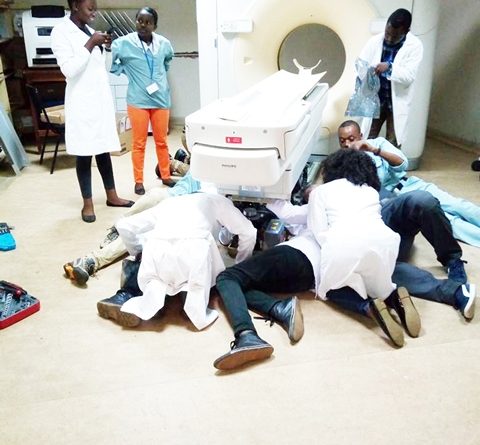Programmes
Bsc in Medical Imaging
Program Code
BSC MILevel
undergraduateDuration
4 yearsOffered as
Generic
Program Description
Medical Imaging (Radiology) is a health profession concerned with the direct administration of radiation, such as x-rays, in disease diagnosis and injury assessment. Medical imaging studies have been a cornerstone in medical diagnosis for decades as they assist in rapid and accurate detection of diseases or injuries which leads to early and proper patient management. Currently, there is no health training institution in Malawi which offers a proper training programme in advanced imaging techniques up to Bachelor’s degree level. Over years, the government of Malawi, through the Ministry of Health (MoH), has been sending individuals recruited to be radiographers to South Africa for further training in advanced imaging techniques but this initiative had proven to be quite costly hence not sustainable. In addition, a large number Malawians requiring specialized diagnosis have been referred to seek such services abroad at high and unsustainable costs, thereby draining the limited forex in Malawi.
Furthermore, one of the recommendations from the Malawi Health Sector Strategic Plan of 2011-2016 was the introduction of a BSc programme in Medical Imaging in Malawi. Considering the above-mentioned gaps, the introduction of this proposed BSc in Medical Imaging programme at will help in producing graduates who will be capable of applying their skills in accurate detection and timely treatment of various pathologies. This will improve the health standards of Malawians in line with Malawi Growth and Development Strategy (MGDS) number III, which is in line with the UN Sustainable Development Goal (SDG) Number 3.
The programme aims to train students to develop knowledge, attitudes and skills in medical imaging in accordance with statutory requirements including quality, ethics and safety. In addition, it shall also educate scientists in medical imaging who are versatile and able to apply principles and techniques in general and advanced imaging procedures. Furthermore, the students shall acquire skills to manage and organize imaging departments in accordance with Good Clinical Practice (GCP) and conduct research and consultancy related to imaging.
Structure of the program
Sem
1
1
-General Biology
-General Chemistry I
-Physics (Mechanics & Thermal Properties of Matter)
-Algebra and Trigonometry
-Language and Communication
-Introduction to Computer
Sem
2
2
-Human Anatomy & Physiology I
-General Chemistry II
-Physics II
-Calculus I
-Technical and Business Communication
-Computer Programming
Sem
3
3
-Fundamentals of Imaging and Professionalism
-Biostatistics
-Safety in Imaging/Radiation Protection
-Physics fro Radiographers
-Pathology for Radiographers
-Radiographic Imaging Processes
Sem
4
4
-Anatomy for Radiographers
-Radiographic Positioning I (Practicum)
-Work Integrated Learning (General Radiography)
-Radiation Physics
-Equipment for General Radiography
-Patient Care for Radiographers (Practicum)
Sem
5
5
Digital Radiography
-Radiophamarcology
-Ethics in Imaging
-Pathology for Radiographers II
-Advanced Computer Applications
-Quality Assurance/QC in Imaging
Sem
6
6
-Radiographic Positioning II (Practicum)
-Work Integrated Learning (Hospital Based)
-Introduction to Nuclear Medicine
-Pattern Recognition
-Cross-Sectional Anatomy
-Research Methods (Project Development)
Sem
7
7
-Interventional Radiography
-Principles of Ultrasound
-Principles of MRI
-Principles of CT
-Principles of Mammography
-Introduction to Radiotherapy
Sem
8
8
-Business Management & Entrepreneurship
-Work Integrated Learning (MRI)
-Work Integrated Learning (CT)
-Work Integrated Learning (Ultrasound)
Work Integrated Learning (Mammography)
-Research Projects
Malawians
Government Sponsored
650,000 MWK
per year
Self Sponsored
1,250,000 MWK
per year
SADC Citizen
Total Fees
450,000 USD
per year
Non-SADC Citizen
Total Fees
500,000 USD
per year
Eligibility
Criteria for Admission
Entry in Year 1: MSCE, “O” Level, IGCSE, and GCE at least six credits including;
Biology, Physics, Chemistry (or Physical Science), Mathematics English.
Entry in Year 2: A-level with at least C grade in the following subject: Physics, Chemistry, and Mathematics, with Biology at “O level.
Entry in Year 3: A Diploma in Radiography from either Malawi College of Health Sciences or any other international University
OR
Any other related qualification from a recognized institution of higher learning may be assessed by the Admissions Office.
Entry in Year 1: MSCE, “O” Level, IGCSE, and GCE at least six credits including;
Biology, Physics, Chemistry (or Physical Science), Mathematics English.
Entry in Year 2: A-level with at least C grade in the following subject: Physics, Chemistry, and Mathematics, with Biology at “O level.
Entry in Year 3: A Diploma in Radiography from either Malawi College of Health Sciences or any other international University
OR
Any other related qualification from a recognized institution of higher learning may be assessed by the Admissions Office.